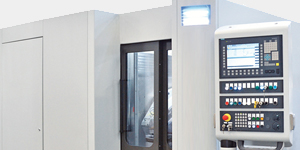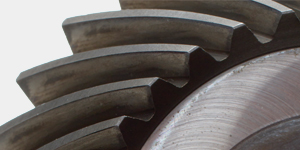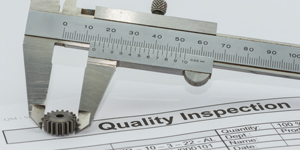By maintaining the size of the base pitch, we can cut the same involute tooth profile with basically any angle of the tool profile, using the relationship in Equation 1:

Where:
tbn = normal base pitch.
mn = normal module.
αn = gear tooth normal profile angle.
With the increase of the tool profile angle, the width of its tip will decrease until it is completely sharpened in order to obtain a constant tooth height. We, therefore, have certain limitations, but on the other hand, there is the possibility of optimally designing the tool in terms of its strength, resistance to wear, and cutting conditions.
The involute shape of the gap formed by the tool can occur at most in the area from the tooth tip to the base circle [1]. Between the involute shape and the root circle, we are dealing with a so-called transition curve. Its shape will depend on the angle of the tool profile at the tip (which is used in tools with protuberance) and the radius of the tool tip rounding. In the case of external teeth cut with a hob, this curve is equidistant to a prolate involute [1].
Although the transition curve or the root fillet generated by the rack tool is referred to by many authors as a trochoid or trochoidal curve [3-7], an analysis of the trochoid definition [8-11] shows that their shapes are different. For the purposes of this article, we will therefore use the term “transition curve.”
Reducing the angle of the generating tool profile leads to the removal of more material at the tooth base in the transition curve area, similarly to reducing the fillet radius at the tool tip. The question arises: Can the change in the shape of the transition curve profile caused by reducing the tool profile angle be compensated by increasing the fillet radius and vice versa? If such compensation was possible, two gears cut with tools with different profile angles and appropriately selected fillet radii of their tips would be indistinguishable because both their involute part and the transition curve would be identical. In such a situation, it would not be possible to clearly determine the parameters of the reference profile of the tool used to cut a given gear. However, if compensation did not occur, analysis of the shape of the transition curve would allow conclusions to be drawn regarding the tool profile. (The involute parts of these gears remain identical.)

Analysis and its results
The initial parameters of the gear that we assume for this analysis are as follows: normal module mn =4.5, profile angle αn =20 degrees, number of teeth z=18, tooth helix angle β=0, pitch circle diameter d=81, basic circle diameter db=76.12, base circle diameter df=70.26, hob tooth tip rounding radius RN=0.9 (0.2mn), profile shift factor x=0.05647, the value of which was determined using Oktoida’s [12] gear calculation software for the condition of not cutting the “c” radii (Figure 1).
The diameter of the beginning of the involute dew=db (is equal to the base diameter). This is graphically presented in Figure 1, which shows the successive positions of the tool blades in the simulation every 2 degrees, which corresponds to a single-start hob with 10 gashes. In the case of helical teeth, the presented procedure will be the same, but the tooth parameters in the normal plane should then be converted to parameters in the transverse plane.

In the case of reducing the tool tip rounding radius from RN0.9 to RN0.225 (0.05 mn) while maintaining its profile angle of 20 degrees (Figure 2), as well as reducing the tool profile angle from 20 to 10 degrees (often used when modifying tools with protuberance), while maintaining its tip radius of RN0.9 (Figure 3), we can observe a greater removal of material at the tooth root, with the other parameters remaining unchanged.
In the case shown in Figure 3, dew=76.43, i.e. already above db=76.12.

Then, using the software for a tool profile angle of 10 degrees, the remaining tool parameters were determined so as to shape the correct profile of the gear teeth in relation to the reference (initial) parameters and the adopted fitting diameter dD=72 in the area of the transition curve where the value of the deviation at the point from the reference profile u=0 (Figure 4).

With the same assumptions, the tool matching parameters were calculated for the profile angle αn =15 degrees (RN =1.6256, mn =4.37779, dew =76.13) and their differences in deviations (parameter “u”) depending on the diameter are presented in Table 1 and Graph 1. Similarly, for both cases, the transition curve can be determined along with the deviations at the tooth base for a different matching diameter dD (where
u = 0), which, for dD = 73, is presented in Table 2 and Graph 2.

The remaining shaping parameters at the matching diameter dD=73 are as follows:
αn =10 degrees RN=2.2119 mn =4.29385 dew=76.16.
αn =15 degrees RN=1.7629 mn =4.37779 dew=76.12.

Due to the strength of the tooth at the root, which is one of the basic strength factors of the toothing [2], the tip radius of the tool cannot be arbitrarily small. The tip edges of the individual blades of the tool shaping the transition curve cause rounding, depending on the value of the tip radius, which is shown in Figure 5a, where the value of this radius is RN=0.225 for a single-thread hob with 10 gashes. The coordinates of the subsequent points of the resulting curve for this case are shown in Table 3.

In order to illustrate the problem of the described phenomenon, using software for determining stresses by the finite element method, the tooth load and stress distribution were simulated for the above case at the tooth base, as shown in Figure 5b. As can be seen, the stress concentration accumulates in places where the tool radius RN is mapped, which can lead to the formation of fatigue notches. Local curvatures in the transition curve area are greater than the radius RN of the tool used and as the number of teeth increases without changing other tooth parameters, they will tend to map it.

If a suitably large tool radius RN is used, the resulting unevenness within the transition curve will be less deviated from local curvatures and will flow more smoothly into them, and the risk of fatigue notches will be lower. The stress distribution at the tooth base will be more evenly distributed and the maximum local stress that will occur will be reduced. With a constant tooth load in relation to the above example, this is shown in Figure 5c, where the transition curve is a smooth curve and does not have point deviations from the RN radii of the tool used.

Since, so far, we have considered cases for a gear with a small number of teeth (z=18), in which the diameter of the gear root circle diameter df is below the base circle diameter db and the teeth themselves are easily undercut, in further analysis it is necessary to consider cases in which the number of teeth in the gear will increase and the root diameter df will be above the base diameter db, which for the number of teeth z=36 is shown in Figure 6, while the remaining parameters are as follows: mn =4.5, αn =20 degrees, β=0, x=0.2, d=162, df=152.55, db=152.23, RN=0.9 (0.2mn ). The profile shift factor was determined from the condition df>db.

Both in the presented case z=36 and all previous ones (for z=18), the tooth profile can be divided into two areas, i.e. the involute area (above the involute diameter dew) and the transition curve area (below the dew diameter down to the root diameter df).

As mentioned in the introduction, while maintaining the size of the basic pitch, a given tooth can be cut with different sets of the normal module and the tool profile angle, as indicated by Equation 1. As a result, the information about which tool was used based on the involute part of the existing tooth flank is irretrievably lost. It is therefore necessary to examine the transition curve in order to obtain such information.

Table 4 shows how the parameters of the teeth made will change as their number increases if these teeth are to be made with a different profile angle (we consider 15 and 10 degrees) than the reference angle αn =20 degrees. The tool radius assumed for the analysis is RN=0.9, the profile shift factor x=0, and the reference normal module mn =4.5.

For the nominal reference profile angle, the radial height of the transition curve area htr decreases with the increase in the number of gear teeth Z and tends to the value of 0.592 mm, corresponding to the height of the radius of the reference profile top rounding, while the calculated height of the reference gear tooth head hfN does not change with the increase in the number of gear teeth. Another situation occurs when we want to cut the same teeth with a different profile angle, where the calculated height of the reference rack tooth addendum hfN depends on the number of gear teeth.

This means that such an interchangeable tool will no longer be universal for different numbers of teeth, thus creating a limitation as to its application. For reference profile angles smaller than the nominal one and larger numbers of gear teeth, htr increases, limiting the area of the involute, and additionally the profiling length of the reference profile increases (a longer tool will be required). When htr increases and, consequently, the involute start diameter dew also gets bigger, the area of the involute profile decreases, which is another limitation that must be taken into account. To better illustrate this, the data from Table 4 is shown in the Graph 3.

And what about the root diameter approaching the pitch diameter of the gear? As a result of profile shift, with a constant number of wheel teeth z=18 and tool tip radius RN=0.9, assuming mn =4.5, αn =20 degrees, we can see the area of the transition curve htr decreases with decreasing distance to the pitch diameter d=81. This happens regardless of the tool profile angle, which is illustrated by the results of the simulation also carried out for profile angles αn =15 degrees (mn =4.37779, d=78.8) and 10 degrees (mn =4.29385, d=77.29), presented in Table 5 and Graph 4.

Conclusions
- The changes in the profile angle of the generating rack are not fully compensated by the changes in the rack tooth tip radius.
- In contrast to the involute, the analysis of the transition curve allows the identification of the parameters of the generating rack, which can be used in reverse engineering.
- In the transition curve area of the gear tooth profile, recesses are cut with radii equal to the generating rack tip rounding, which act as stress concentrators.
- With the increasing number of teeth of the gear and the area of the transition curve approaching the pitch diameter of the gear with the tip radius of the generating gear remaining constant, the height of this area decreases.
- The height of the transition curve area will increase when changing the rack profile angle to a smaller one while maintaining the rack base pitch and its tip radius.
- The obtained results of the analysis show a wide spectrum of its use in practice and are proof of having a large control over the course of the curve at the tooth base already at the design stage of both the gear and the tools, allowing to avoid errors not only due to geometric reasons of the meshing of the wheels being made, but also due to strength reasons. They provide the possibility of use in reverse engineering and can be the subject of further detailed studies.

References
- Ochęduszko, Kazimierz.: Gears. Construction, WNT, 1966.
- Muller, Ludwik.: Gear design, WNT, 1979.
- Radzevich, S. P.: Dudley’s Handbook of Practical Gear Design and Manufacture, CRC Press, 2012.
- Kapelevich, A. L.: Direct Gear Design, CRC Press, 2013.
- Stadtfeld, H. J.: The Undercut Phenomenon, Gear Technology September/October 2021, https://www.geartechnology.com/ext/resources/issues/0921x/ask-the-expert.pdf. Accessed 9 Jul. 2024.
- Buckingham, E.: Analytical Mechanics of Gears, McGraw-Hill Book Company, 1949.
- Xiaogen Su, Houser, D.R.: Characteristics of trochoids and their application to determining gear teeth fillet shapes, Mechanism and Machine Theory 35 p. 291-304, 2000.




























